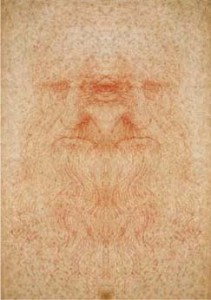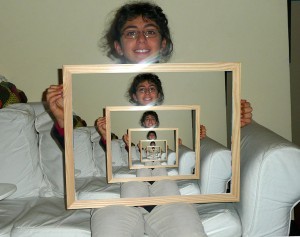Mirror Neurons, Nonduality & Perception
Take a look at yourself in the mirror. It’s time for some self-reflection. I need to find myself. We have no idea what we’re saying, but the principle of reflection is deeply embedded in the way we talk about our inner world. With the discovery of mirror neurons, it could be that a new neural network is opening for the contemplation of human interdependency, empathy and the deeper nature of consciousness.
 The scientific anecdote has it that in the ‘eighties and ‘nineties some Italian neurophysiologists – Rizzolatti, Di Pellegrino, Fadiga, Fogassi, and Gallese at the University of Parma, had the ventral premotor cortex of a macaque monkey hooked up with electrodes to study neurons specialized for the control of hand and mouth actions. Each time the monkey picked up a peanut to eat, his brain would signal: “click, click, click”. One day, (goes the story) one of the researchers himself took a peanut and began to eat it, as the monkey watched. The same sound “click, click, click,” resonated through the monitor, although the monkey hadn’t moved an inch. Other stories involve an ice-cream, so perhaps the phenomena – which at first became known as “monkey see, monkey do” – was rechecked with a whole culinary range.
The scientific anecdote has it that in the ‘eighties and ‘nineties some Italian neurophysiologists – Rizzolatti, Di Pellegrino, Fadiga, Fogassi, and Gallese at the University of Parma, had the ventral premotor cortex of a macaque monkey hooked up with electrodes to study neurons specialized for the control of hand and mouth actions. Each time the monkey picked up a peanut to eat, his brain would signal: “click, click, click”. One day, (goes the story) one of the researchers himself took a peanut and began to eat it, as the monkey watched. The same sound “click, click, click,” resonated through the monitor, although the monkey hadn’t moved an inch. Other stories involve an ice-cream, so perhaps the phenomena – which at first became known as “monkey see, monkey do” – was rechecked with a whole culinary range.
What the results consistently revealed was that an observed action in another, can signal the same brain response in the monkey as action taken by the monkey itself. The neurons that fired in this act of empathy towards someone else’s body have been called Mirror Neurons.
We can all easily recognize these theorized mirror neurons at work, each time we clutch our heads in despair when the player misses the penalty, when we’re watching an intense drama on TV, or in any simple act of emotional engagement with situations that are none of our business. When I was one years old, my brother cut his leg. My response was to not walk myself for a week. Were these early mirror neurons taking physical empathy a little too far through the hardly shielded infant brain?
“I predict that mirror neurons will do for psychology what DNA did for biology.”
Prof. V.S. Ramachandran
The new millennium has witnessed an expanding wealth of research and debate over the existence, role and potential of mirror neurons. The functioning of mirror neuros (or lack of) has been linked theoretically to autism; they have been described as critical in processes of learning, mimicry, and even in the evolutionary leap from Neanderthal to today’s splendid example of human.
While scientific dissenters have attempted to puncture the hype, casting doubt on the existence of such neurons in humans, as well as on their task and location in the brain, research is only now unfolding into the scientific implications of what some neuroscientists, such as Prof. Vilayanur Ramachandran, have indicated could be the biological seat of our capacity for empathy.
To a pseudo-scientific nondualist, the philosophical implications of the discovery of mirror neurons are inspiring.
Experientially, it’s not surprising that we have brain cells that translate the actions of another body in the same way that they translate the actions of my own body. The only bit in the brain left unfired is the connection to direct sensory perception through the nerves in the hand, or taste buds that actually signal the precise saltiness of the peanut. Observation of my body doing something – from the perspective of the brain – is not so critically different from the observation of your body doing that thing. The experience (which is always in the moment) can be the same, it’s just that you get to carry the consequences in your flesh and I don’t.
The unconditioned consciousness that witnesses the movements of physical, mental and emotional form is understood as fundamental to our reality. This witness is not memory dependant, but as experience can only be experienced in the present moment, it is directly alive at the gateway between our perceiving source and the traction of life.
To a nondualist, these mirror neurons would seem to be a form reflecting a wider apparatus connected with the nature of consciousness. In the area of theory, perhaps a nondual perspective can enrich the current debate on mirror neurons.
Trauma
 If mirror neurons are fired when we are able to empathize with the emotions or feelings of another person, then they are also that which fires when we empathize with the emotions or feeling of our own ‘person’.
If mirror neurons are fired when we are able to empathize with the emotions or feelings of another person, then they are also that which fires when we empathize with the emotions or feeling of our own ‘person’.
Many of us perhaps recognize traumatic states, when we get sucked down the rabbit hole of pain and vulnerability and our universe shrinks to survivalist proportions. Such states narrow our consciousness and close down our sense perceptions.
If we were able to relate to ourselves at such times (“The smaller me is suffering a traumatic state now-“) and empathise with it, through the use of mirror neurons, then a new spaciousness could be allowed in which new healing possibilities emerge through freedom of perspective. We can “take care” of ourselves, in the same way that we would care of any loved one, as we are not ultimately the form which is suffering.
Inter-being
It is clear that in the empathic movement between my peanut and the professor’s peanut, that the idea of a separate self has experientially broken down. A physical peanut for one, is an experiential peanut for all.
It’s not only nonphysical pain which is shared, but also the non-physical components of happiness, fulfilment, grace or bliss. This is happening biologically of itself, to be blocked only by the active neglect or repression of mirror-neuronal firing.
Such repression (it’s not ‘my’ happiness, it’s ‘his’) is the root of jealousy, competition, suffering and war. Allowance and cultivation of the mirror neuron (like those found in our simple monkey) could lead to a kind of manifest unity and realistic flow of interdependence that could provide a utopian model for any community or society.
Who am I again?
On the other hand, when we really move into the perceptive experience of being alive, it can become increasingly clear that our whole interpersonal sensory reality is composed of our perceptions of others and the environment. We see the facial responses, struggles, egos and accidents of others from many perspectives, whereas we are physically unable to see ourselves in such living totality.
The closest we get in visual input about our own physical objectivity is through photographs, video recordings and mirrors on the wall. But a vast amount of sensory data and perspective is excluded from these forms. Mirror neurons invite us to realize that our reality was never separable from the whole. Who did we think we were fooling in thinking it could be?
The Mirror in the Mirror
 Yet it gets even more exciting. This non-physical, empathic ability of mirror neurons to fire in response to the perception of “others”, also gives us the ability to empathize with ourselves as if we were also “other”.
Yet it gets even more exciting. This non-physical, empathic ability of mirror neurons to fire in response to the perception of “others”, also gives us the ability to empathize with ourselves as if we were also “other”.
Because of mirror neurons, we (the subject) are also able to reflect on our own identity, emotional patterns, instinctive drives (the objects of inner perception). We are able to have empathy for another form, but also for and our own ‘inner’ form.
But what happens when a mirror neuron has empathy for empathy itself? What happens when the mirror neuron’s awareness turns to the other mirror neuron, and becomes aware that it is aware? What is then reflected?
The brain is still busy, firing reflections but now it is reflecting its own capacity for reflection, like a tunnel of mirrors into infinity. On a cellular level, we are becoming aware that we are aware, that we are aware, in increasing degrees of refinement and liberation from normal perceptive constraints. Could this be a neurophysiological explanation for the phenomena of awakening?
Where Binary Brain Surrenders
Now we have no choice but to take ourselves as the laboratory monkey. In the experience of awareness of awareness, the tunnels of mirror into infinity, somewhere, the wiring of the brain seems to flip over. The effect is the collapse of the sense of a separate self. It comes with existential impressions of the eternal self and the infinity of love and peace. It defaults to a deep, contented sense of being, unconditionally to circumstances of pleasure, pain, failure or success. In short, it seems to be a good thing, and also an intensely kind, generous and sociable form that emerges.
In the collapse of subject object, seen already in the monkey salivating over the professor’s ice-cream, a more evolved layer of mind begins to fire up (which surely, one day, they will find in neurons). This kind of mind is less identified yet more ingenious. It moves beyond the either-or equations of subject and object and into the “and-and” equations that more reflect life (also the professor and also the monkey eat peanuts). In developing the ability to relax into paradox, many possibilities, and many feelings, there is an increasing surrender in responsivity to the needs of the environment in any moment.
Neurons multiply according to how often they are fired. That is, the more you walk a particular path through the forest of the mind, the more likely you are to walk it. This is the nature of education and training. We learn through resonating with the “other”, then we do it ourselves (as we have already walked that path with our teacher), and then we do it often. The more often we walk the path, the more it widens. The more we practise self-reflection and empathy, the more mirror neurons we have at our disposal, and the easier it becomes to disentangle and to access this deeper existential layer of being at one with the whole, without conflict. We find more freedom in form.
“It is extraordinary how near we are to our deeper being. It’s just a thought away.”
Ram Dass – Polishing the Mirror
One Evolution
When we move to subtler frequencies of brain, such as that of timeless, unattached consciousness, or the resonance of unbounded being, these mirror neurons and the effects of them is also firing through all the brains in the vicinity. Could this not be a biological reflection of what has been called the transmission of enlightenment from teacher to student?
If what’s true of a peanut is true also of the neuronal resonance with the experience of unlimited consciousness, then the liberation of our own perception from the entanglement with thought limitations and the attachment to emotional patterns would have an immediate physiological impact on everyone around us – without us moving a muscle of saying a word.
I AM HERE - Opening the Windows of Life & Beauty
- Georgi Y. Johnson's profile
- 30 followers



